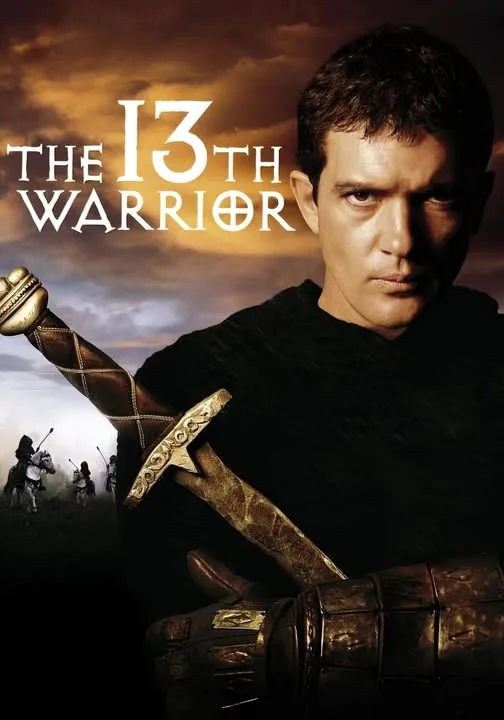The 13th Warrior (1999)
Set in the 10th century, The 13th Warrior tells the story of Ahmad ibn Fadlan, an educated and refined Arab court poet living in Baghdad. After falling into disfavor due to a romantic entanglement with a nobleman's wife, Ahmad is exiled by the Caliph and sent on a diplomatic mission to the distant lands of the North. Accompanied by his loyal servant Melchisidek, he travels through unknown territories until they encounter a group of Norsemen, or Vikings. At first, Ahmad is appalled by their crude manners, their rough speech, and seemingly barbaric ways, which sharply contrast with his own cultured background. However, he is soon drawn into their world in ways he never imagined. The Viking camp receives a visitor—an old messenger from King Hrothgar, whose kingdom in the North is being terrorized by an ancient evil. A mysterious force referred to only as "the Eaters of the Dead" has returned, slaughtering villagers and devouring their remains. According to legend, the threat can only be defeated by thirteen warriors, and the last of them must be one who is not a Northman. Reluctantly, and to his great surprise, Ahmad is chosen as the thirteenth warrior. Though he protests, he is honor-bound to accept, and so he embarks on a perilous journey with the Norsemen toward a land besieged by fear.
At first, Ahmad is the outsider, unable to speak their language and unskilled in their brutal combat style. But as they travel together, he begins to observe and learn. Through careful listening and intelligence, he slowly picks up the Viking tongue. He also starts to grasp their values: loyalty, courage, and honor in battle. Despite his initial reservations and differences, Ahmad begins to bond with his fellow warriors, especially with Herger the Joyous, who becomes his friend and cultural bridge. The group’s respect for Ahmad also grows as they see his bravery and quick thinking, even though he is not as physically strong or fierce as they are. When they arrive at King Hrothgar’s village, the situation is worse than expected. The villagers live in constant terror. At night, shadowy figures descend from the hills, slaughtering indiscriminately and vanishing into the mist. The attackers are believed to be the Wendol—ancient creatures of legend, part man, part beast, who wear bear hides and strike with brutal force. The Vikings and Ahmad begin to mount defenses, constructing barricades and organizing the villagers. Several attacks occur, leaving the warriors bloodied but alive, and they begin to understand the Wendol’s patterns. As they gather clues, it becomes clear that the Wendol are not supernatural monsters, but a primitive, savage tribe that uses myth, ritual, and terror to maintain control. During a scouting mission, the warriors find the remains of a previous attack and realize that the Wendol are led by two powerful figures: a war chief and a matriarch known as the “Mother of the Wendol.” To break their power, both must be killed. The Norse warriors endure multiple skirmishes, suffering injuries and losses. Ahmad, meanwhile, undergoes a personal transformation. He learns how to wield a scimitar effectively, adapts to the Vikings' survival tactics, and becomes more than just a scholar—he becomes a warrior in his own right. In a particularly symbolic moment, he recites a prayer before battle that mirrors the Vikings' own warrior creed, showing how deeply he has embraced their way of life. The final act of the film revolves around a desperate plan to end the Wendol threat once and for all. The warriors decide to infiltrate the Wendol’s cave sanctuary to assassinate their matriarch. In a harrowing sequence deep underground, Ahmad and a few surviving comrades confront the ancient Mother. The scene is intense, symbolic, and almost mythical—she is portrayed as a living embodiment of a forgotten era, ruling her people through fear and ritual. The Vikings manage to kill her, but not without cost. Several are wounded or killed, and the mission leaves them exhausted. Their work is not yet done, however—the Wendol war chief still lives and must be faced in open battle.
The climax comes as the Wendol launch one final assault on the village. The few remaining warriors, joined by villagers, prepare for a last stand. Thunder crashes as the Wendol ride into battle. Ahmad, now fighting side by side with the Norsemen as an equal, joins them in a fierce and bloody confrontation. In a moment of bravery and desperation, the warriors face the Wendol leader in personal combat. With the death of the chieftain, the Wendol retreat into the mist, defeated and leaderless. Peace returns to the land, but at great cost—many warriors have fallen, and their sacrifices are honored with solemn rituals. In the aftermath, Ahmad reflects on his incredible journey. He arrived as an outsider, an intellectual forced into exile, but he departs as a changed man—someone who has fought, survived, and earned the respect of men very different from himself. He records his experiences in his journal, noting the courage and honor of the warriors he once feared and misunderstood. The film ends with him preparing to return to the civilized world, carrying with him the lessons of the North and the spirit of the thirteen warriors. Through his transformation, The 13th Warrior delivers a story not only of action and adventure, but of cultural understanding, personal growth, and the power of shared humanity in the face of darkness.


-1739583896-q80.webp)

